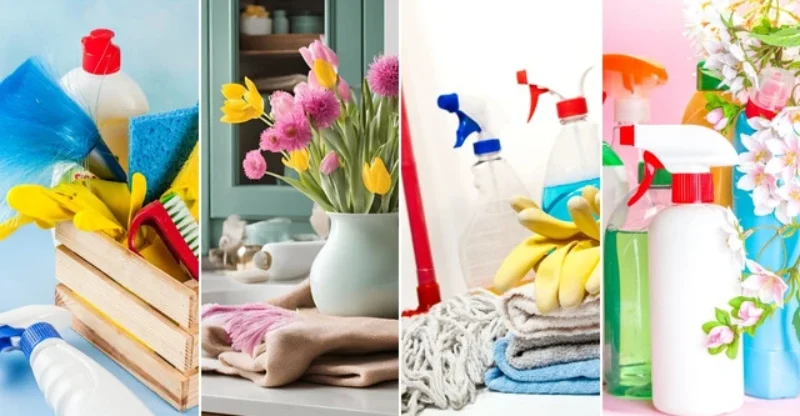10 Spring Cleaning Tips for a Fresh and Spotless Home
As the days grow longer and the weather warms up, many individuals feel inspired to refresh their homes. Spring cleaning is not just about tidying up; it provides an opportunity to declutter, reorganize, and create a more enjoyable living environment. Tackling common areas like the kitchen, bedrooms, and bathrooms can transform spaces and enhance overall comfort.
To achieve the best results, creating a systematic plan is essential. She can start by focusing on one room at a time, prioritizing tasks that often get overlooked during regular cleaning. Incorporating practical tips can help streamline the process and make spring cleaning feel less daunting.
By embracing effective methods and a positive mindset, anyone can turn the daunting task of spring cleaning into a rewarding experience. With these tips, they can look forward to a cleaner, brighter space that fosters productivity and relaxation.
1. The Benefits of Spring Cleaning
Spring cleaning offers several practical advantages for individuals and households. It provides an opportunity to refresh living spaces and promotes a sense of order.
1. Improved Air Quality
Dust, allergens, and pollutants can accumulate over time. Cleaning surfaces and decluttering can enhance indoor air quality, making the environment healthier.
2. Increased Space
Decluttering creates more space in homes. It helps individuals assess items that are no longer needed, allowing for better organization.
3. Mental Clarity
A clean environment contributes to mental well-being. Tidying up can reduce stress and promote a clearer mind, aiding focus and productivity.
4. Enhanced Aesthetics
Spring cleaning revitalizes living areas. A clean, organized space looks inviting, improving the overall appearance of a home.
5. Maintenance of Belongings
Regular cleaning helps maintain possessions. It allows for inspections of items, ensuring that they remain in good condition and prolonging their lifespan.
6. Goal Setting
Spring cleaning serves as a motivator for setting goals. Individuals can create a list of tasks, fostering a sense of accomplishment as they complete each one.
Incorporating these practices during the spring not only transforms physical spaces but also positively impacts individuals’ emotional health.
2. Planning Your Spring Cleaning Strategy
A solid spring cleaning strategy requires careful planning. Effective organization ensures every area is addressed and responsibilities are clearly defined.
Creating Your Checklist
A comprehensive checklist is essential for an efficient spring cleaning process. Start by identifying each room and its specific needs. Break tasks down into manageable steps, such as:
- Dusting surfaces
- Vacuuming or mopping floors
- Organizing closets
- Cleaning windows
Incorporating prioritized tasks ensures that important areas are addressed first. It’s helpful to use a digital app or a paper checklist, allowing for easy updates as tasks are completed.
Additionally, consider adding deadlines to specific tasks to maintain momentum. A well-structured checklist not only makes the process smoother but also provides a sense of accomplishment as items are checked off.
Allocating Time and Responsibilities
Designating time for cleaning tasks can enhance productivity. Each room may require varying amounts of time; for example, a kitchen may need more focus than a bathroom.
Distributing responsibilities among family members or housemates can also lighten the workload. Assign specific tasks based on individual strengths or preferences. For instance:
- One person tackles the kitchen
- Another focuses on the living room
Setting a shared timeline can encourage accountability and teamwork. Use a shared calendar or a group messaging app to coordinate schedules and remind each other of upcoming tasks. This organized approach fosters collaboration and ensures a thorough clean.
3. Decluttering Your Space
Creating a clean and organized environment begins with effective decluttering. This process involves assessing belongings and arranging them thoughtfully to maximize space and accessibility.
Sorting Through Your Belongings
Start by gathering all items from a specific area into one space. This can include clothing, books, and miscellaneous objects.
Next, examine each item and categorize them into four groups:
- Keep: Items that are frequently used or have significant value.
- Donate: Gently used items that someone else could benefit from.
- Sell: Items in good condition that can be sold online or at a garage sale.
- Trash: Broken or unusable items that should be discarded.
This process helps to clarify what is genuinely needed, allowing for a more intentional collection of belongings.
Organizing as You Go
Organizing should occur simultaneously with sorting to enhance efficiency. Once items are categorized, find suitable storage solutions for each group.
For kept items, use clear bins or labeled boxes to create a system that allows for easy access. For donated items, have a separate bag or box ready to transport them promptly.
Selling items can be organized into a dedicated space until they are listed or sold. It’s best to dispose of trash immediately to avoid re-evaluating unwanted items.
Maintain this organized approach in future cleaning sessions to prevent clutter from accumulating again.
4. Cleaning Supplies and Tools
Having the right cleaning supplies and tools is essential for an effective spring cleaning. This section covers the necessary essentials and introduces eco-friendly alternatives for conscientious cleaning.
Essential Supplies
To tackle any spring cleaning task, a few essential supplies are indispensable. Begin with multi-surface cleaners, which can handle a variety of surfaces, from countertops to floors.
A strong, yet safe, disinfectant should be included to eliminate germs, especially in high-traffic areas.
A good set of microfiber cloths is crucial for dusting and wiping surfaces without leaving lint behind. Sponges and scrub brushes in different sizes help tackle tougher grime.
Don’t forget a vacuum cleaner with various attachments for carpets, upholstery, and hard-to-reach places. Broom and dustpan sets complement this equipment by effectively handling larger debris, making them vital for any spring cleaning kit.
Eco-Friendly Alternatives
For those looking to maintain an eco-conscious approach, several effective alternatives exist. Vinegar is a versatile cleaner, useful for removing odors and breaking down mineral deposits. It can be mixed with water for general cleaning or used directly on tougher stains.
Baking soda serves as a powerful scrubber, ideal for removing grease and stains from surfaces. It can also neutralize odors when sprinkled in carpets.
Many companies offer biodegradable cleaning products that are both effective and gentle on the environment. Look for options labeled as non-toxic or free from harsh chemicals.
Using reusable cleaning cloths instead of disposables not only cuts down on waste but also provides effective cleaning without using chemicals. These eco-friendly choices ensure a thorough clean while protecting the planet.
5. Room-by-Room Cleaning Tips
Effective spring cleaning requires a systematic approach. Addressing each room with focused techniques ensures a thorough deep clean and organization.
Kitchen Deep Clean
Begin by emptying cabinets and drawers. Wipe down surfaces with a mixture of vinegar and water to eliminate grime and germs.
Focus on appliances. Clean the oven with a baking soda paste, and use a vinegar solution for the microwave. Don’t forget to defrost the refrigerator.
Tackle the floors last. Sweep and mop for a fresh finish. Organize pantry items, discarding expired food.
Bathroom Sanitization
Start with high-touch areas. Disinfect light switches, doorknobs, and faucet handles to reduce germs.
Clean the toilet thoroughly with a bathroom cleaner and a brush. Wipe down the shower walls with a solution of equal parts vinegar and water.
Focus on mirrors and sink surfaces for a streak-free shine. Finally, organize toiletries and discard items no longer needed.
Living Room Refresh
Begin by dusting surfaces, including shelves and picture frames. Use a microfiber cloth to attract dust effectively.
Vacuum upholstered furniture and clean cushions. Consider rotating or flipping them for even wear.
Focus on the floors next. Vacuum carpets and mop hard surfaces, then organize books and décor to maintain an inviting space.
Bedroom Organization
Start by clearing clutter. Remove items from nightstands and dressers, and sort through clothing. Donate items that are no longer worn.
Dust surfaces and clean under the bed. Use storage bins for seasonal clothes to maximize space.
Make the bed with fresh linens for an immediate visual impact. Maintain a tidy environment by establishing a daily tidying routine.
Home Office Upkeep
Clear the desk of unnecessary papers. Shred documents that are no longer needed and file important ones immediately.
Dust electronics and surfaces to eliminate buildup. Use a microfiber cloth on screens to prevent scratches.
Organize office supplies into designated containers. Consider a digital declutter of files on computers for better efficiency.
6. Tackling Dust and Allergens
Dust and allergens can accumulate quickly, triggering allergies and respiratory issues. Effective spring cleaning can help mitigate these risks.
Essential Tools:
- Microfiber cloths
- Vacuum cleaner with HEPA filter
- Duster
- Allergy-friendly cleaning solutions
Steps to Follow:
- Declutter: Remove unnecessary items from surfaces. This reduces places where dust can settle.
- Dusting: Start from the highest points in the room. Use a microfiber cloth to trap dust, rather than pushing it around.
- Vacuuming: Use a vacuum with a HEPA filter. Pay special attention to carpets, rugs, and upholstery, as they can harbor allergens.
- Wash Fabrics: Launder curtains, cushion covers, and bedding. Use hot water to kill dust mites and allergens.
- Air Quality: Consider using an air purifier. This helps to filter out dust and allergens from the air.
Helpful Tips
- Clean often, especially in high-traffic areas.
- Change air filters regularly to keep air circulating cleanly.
Taking these steps can significantly reduce dust and allergens in the home, providing a healthier environment.
7. Upholstery and Carpet Care
Spring cleaning includes maintaining upholstery and carpets to improve their lifespan and appearance. Regular care helps prevent dirt and allergens from building up.
Vacuuming
Frequent vacuuming removes surface dirt and dust. It is recommended to vacuum carpets at least once a week and upholstery every two weeks.
Spot Cleaning
For stains, act quickly. Use a clean cloth to blot, not rub. Common spot cleaning solutions include:
- Water and mild detergent
- White vinegar and water
- Baking soda paste for tough stains
Deep Cleaning
Consider deep cleaning carpets and upholstery annually. Professionals use methods like steam cleaning to eliminate deeper grime and allergens.
Protective Measures
Using furniture covers and rugs can protect upholstery and carpets. These are especially useful in high-traffic areas.
Maintenance Tips
- Rotate cushions and pillows to ensure even wear.
- Use coasters and trays to prevent spills on upholstery.
- Avoid excessive sunlight to prevent fading.
By integrating these practices into regular cleaning routines, they can significantly maintain the condition of carpets and upholstery throughout the seasons.
8. Window and Glass Surface Cleaning
Cleaning windows and glass surfaces can greatly enhance the overall appearance of a home. A clear view and sparkling surfaces allow natural light to brighten indoor spaces.
Materials Needed
- Bucket: For mixing cleaning solution.
- Squeegee: Ensures a streak-free finish.
- Microfiber Cloths: For drying and polishing.
- Cleaning Solution: Use a mix of water and vinegar or a commercial glass cleaner.
Steps for Cleaning
- Prepare the Cleaning Solution: Combine equal parts of water and vinegar in the bucket.
- Apply the Solution: Use a microfiber cloth to apply the solution to the glass surface.
- Squeegee Action: Start from the top corner of the window and pull the squeegee down in a straight line. Wipe the squeegee with a cloth after each pass to avoid streaks.
- Final Touch-Up: Use a dry microfiber cloth to buff away any remaining spots.
Tips
- Clean windows on a cloudy day to prevent the solution from drying too quickly.
- Use a ladder safely for hard-to-reach windows, ensuring it’s stable.
- Consider cleaning screens separately if applicable.
Consistent cleaning after seasonal changes helps maintain clarity and prevents buildup. By following these steps, anyone can achieve spotless windows and glass surfaces.
9. Maintaining a Clean Home Post-Spring Cleaning
After a thorough spring cleaning, establishing habits for cleanliness is essential. Consistent daily and weekly routines help preserve the fresh environment. Attention to specific tasks ensures that a home remains tidy and appealing.
Daily Cleaning Habits
Incorporating daily cleaning habits sparks a significant impact on maintaining a tidy home. Some effective practices include:
- Make the Bed: Start the day by making the bed, which instantly improves room appearance.
- Clean as You Go: When cooking or using a space, clean up immediately to prevent mess accumulation.
- Wipe Surfaces: Spend a few minutes each day wiping down kitchen counters and dining tables to remove spills and crumbs.
- Tidy Up High-Traffic Areas: Quickly organize areas like the entryway and living room at the end of the day to maintain order.
Sticking to these simple tasks fosters a clean atmosphere without overwhelming effort.
Weekly Maintenance Routines
Setting aside time each week for maintenance ensures continued cleanliness. Key tasks for a successful routine include:
- Dusting: Dust surfaces in all rooms, paying special attention to shelves, electronics, and light fixtures.
- Vacuuming and Mopping: Vacuum carpets and rugs, and mop hard floors to remove dirt and debris.
- Bathroom Cleaning: Dedicate time to scrub sinks, toilets, and showers. Regular cleaning prevents buildup and unpleasant odors.
- Laundry: Designate a day for laundry to avoid a pileup of clothes. This keeps wardrobes organized and fresh.
By committing to these weekly tasks, cleanliness becomes manageable and hassle-free.
10. Proper Disposal and Donation of Unwanted Items
When decluttering, it’s crucial to dispose of unwanted items responsibly. Several options are available for disposal and donation.
Donation Centers
Many organizations accept donations. Some popular choices include:
- Goodwill
- Salvation Army
- Habitat for Humanity ReStores
Ensure items are in good condition. Contact local centers for specific guidelines.
Recycling Options
Certain materials can be recycled. Check local recycling programs for:
- Electronics: Many municipalities offer electronic waste collection days.
- Scrap Metal: Local scrap yards often accept metal items.
Disposing Hazardous Materials
Items like batteries and chemicals require special disposal. Residents should follow city regulations for hazardous waste collection.
Types of Items
Not all items are suitable for donation. Refer to this list:
- Acceptable: Clothing, furniture, household goods
- Not Acceptable: Damaged items, personal hygiene products, or expired food
Preparation for Donation
Before donating, please clean items and ensure they are in working order. This increases the likelihood of acceptance.
Scheduling Pick-Ups
Many organizations offer pick-up services for larger items. Schedule online or by phone for convenience.
Proper disposal and donation practices benefit the community and environment. Choose the most suitable method for unwanted items and ensure a responsible clean-out process.
11. Safety Precautions During Cleaning
When undertaking spring cleaning, safety should be a priority. Proper precautions help prevent accidents and injuries.
1. Use Protective Gear
- Wear gloves to protect hands from harsh chemicals.
- Use masks to avoid inhaling dust and fumes.
- Safety goggles can prevent eye irritation from sprays and dust.
2. Ensure Proper Ventilation
Good airflow is crucial when using cleaning products. Open windows and doors to allow fresh air in. Use fans to help circulate air and reduce the concentration of any airborne chemicals.
3. Read Labels Thoroughly
Always read the instructions on cleaning products. Understanding the usage and potential hazards helps avoid mishaps. Follow recommended safety guidelines to minimize risks.
4. Store Chemicals Safely
Keep cleaning supplies stored in a safe place. Ensure they are out of reach from children and pets. Label all containers and never mix different chemicals, as this can create toxic reactions.
5. Maintain Clear Pathways
Remove clutter from walkways to prevent trips and falls. Ensure all cleaning tools are organized and stored properly after use. Keeping the area tidy promotes a safer cleaning environment.
6. Use Step Stools Safely
When reaching high places, use a sturdy step stool. Avoid standing on chairs or unstable surfaces. Ensure the stool is stable and placed on flat ground to prevent accidents.



